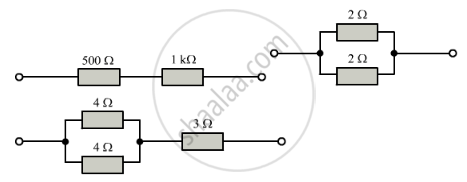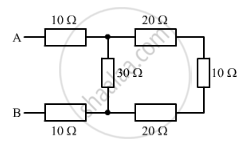Advertisements
Advertisements
प्रश्न
The resistance of two resistors joined in series is 8Ω and in parallel is 1.5Ω. Find the value of the two resistances.
उत्तर
In series, R1 + R2 = 8 Ω
In parallel `("R"_1"R"_2)/("R"_1 + "R"_2) = 1.5` Ω
∴ R1R2 = 8 × 1.5 = 12 Ω
Now (R1 - R2)2 = (R1 + R2)2 - 4R1R2
∴ (R1 - R2)2 = (8)2 - 4 × 12
or (R1 - R2)2 = 64 - 48 = 16
or R1 - R2 = 4 Ω
On solving equations (i) and (ii) R1 = 6 Ω and R2 = 2 Ω
APPEARS IN
संबंधित प्रश्न
Find the expression for resistors connected in series.
A piece of wire of resistance R is cut into five equal parts. These parts are then connected in parallel. If the equivalent resistance of this combination is R’, then the ratio `"R"/"R'"` is ______.
Two resistors of 4Ω and 6 Ω are connected in parallel to a cell to draw 0.5 A current from the cell.
(i) Draw a labelled circuit diagram showing the above arrangement.
(ii) Calculate the current in each resistor. What is an Ohmic resistor?
Calculate the combined resistance in each case:


You are supplied with a number of 100 Ω resistors. How could you combine some of these resistors to make a 250 Ω resistor?
Name the material of wire used for making standard resistances. Give a reason.
Four resistances of 2.0Ω each are joined end to end, to form a square ABCD. Calculate the equivalent resistance of the combination between any two adjacent comers.
Two wires of the same length and area made of two materials of resistivity ρ1 and ρ2 are connected in series to a source of potential V. The equivalent resistivity for the same area is:
Show how you would connect three resistors, each of resistance 6 Ω, so that the combination has a resistance of 4 Ω.
